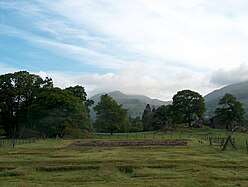54°25′20″N 2°58′08″W / 54.4223°N 2.9688°W
| Ambleside Roman Fort | |
|---|---|
 | |
| Known also as | Galava |
| Place in the Roman world | |
| Province | Britannia |
| Nearby water | Windermere |
| Location | |
| Coordinates | 54°25′20″N 2°58′08″W / 54.4223°N 2.9688°W |
| Place name | Waterhead |
| Town | Ambleside |
| County | Cumbria |
| Country | England |
| Reference | |
| UK-OSNG reference | NY372034 |
| Site notes | |
| Archaeologists | R. G. Collingwood, F. Haverfield, R. H. Leech |

Ambleside Roman Fort is the modern name given to the remains of a fort of the Roman province of Britannia. The ruins have been tentatively identified as those of either Galava or Clanoventa, mentioned in the Antonine Itinerary.[1] Dating to the 1st or 2nd century AD,[2] its ruins are located on the northern shore of Windermere at Waterhead, near Ambleside,[3] in the English county of Cumbria,[4] within the boundaries of the Lake District National Park.[3]
The fort guarded the Roman road from Brougham to the Roman fort of Glannoventa by the sea at Ravenglass, by way of Hardknott Roman Fort. There is also assumed to have been a road south to the fort at Kendal. In 2016 it was reported that LIDAR technology had revealed a Roman road running north from Ambleside fort to Carlisle, and another running northwest to Papcastle.[5] These roads had been previously described by John Horsley in his Britannia Romana of 1732.
The ruins are a Grade I listed structure.[6] The site is open to the public, and is owned and managed by the National Trust.[7] The site is a scheduled monument with list entry numbers of 1009348 and 1244785 (formerly RSM 13567 and RBS 450573)[6][8]
- ^ Smith 1997, pp. 372, 374, 378.
- ^ English Heritage 2004.
- ^ a b Ordnance Survey 2011.
- ^ English Heritage undated 1.
- ^ "Lasers reveal 'lost' Roman roads". GOV.UK. Environment Agency and Department for Environment, Food & Rural Affairs. 3 February 2016. Archived from the original on 3 February 2016. Retrieved 19 January 2022.
- ^ a b Historic England, "Ambleside Roman fort, associated vicus and Roman road (1009348)", National Heritage List for England, retrieved 5 February 2018
- ^ English Heritage undated 2. Taylor 2013, p. 2.
- ^ Historic England, "Borran's Field (Galava Roman Fort) (1244785)", National Heritage List for England, retrieved 5 February 2018
